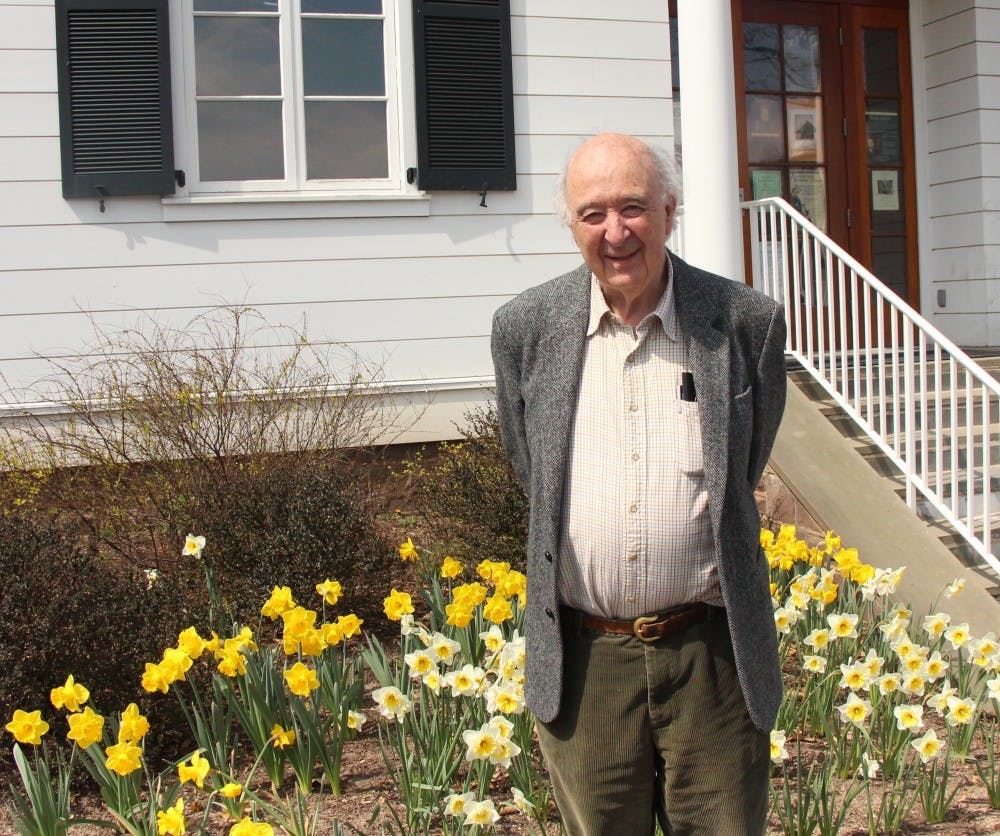The fall of the Roman Empire ushered in a dark age, replete with decay and barely worth studying. Or so scholars thought until history professor emeritus Peter Brown invented the field of late antiquity, which spans 250–800 A.D.
“Looking at the late antique world, we are caught between the regretful contemplation of ancient ruins and the excited acclamation of new growth,” he wrote in his 1971 book “The World of Late Antiquity.”
Brown’s discovery of the era’s dynamism has driven his career. Specializing in the transition from ancient to medieval times, as well as the rise of Christianity, he has authored a dozen books, garnered numerous honors, and earned international acclaim.
“Peter Brown is surely one of the great historians of our time,” said history professor Helmut Reimitz. “He changed the ways that we think about the end of the Roman world and the beginning of the medieval and European and, if you like, Western society and civilization.”
Dimitri Gondicas, executive director of the Program in Hellenic Studies, explained that Brown shows how people in the past envisioned themselves.
“It’s what we call history in the longue durée and from the ground up, not merely events, officials, dates, and battles,” Gondicas said.
For Brown, the treasures of late antiquity first emerged through art. On a trip to Ravenna, late Roman mosaics overwhelmed him with their sheer beauty. Intrigued, he set out to understand how the Roman Empire transitioned into the Middle Ages.
Late antiquity contains so much wisdom about how people overcome difficult conditions, rendering the field relevant to contemporary individuals, Brown said.
“I’m much more interested in how people survive than how they make great things. Great achievements are wonderful, but the real test of a culture is how it passes itself on,” he explained.
Born to Irish Protestants in 1935, Brown grew up on two of the continents that he has explored in a scholarly context, Europe and Africa. For the first four years of his life, until World War II broke out in 1939, Brown spent every winter and spring in what was then the Anglo-Egyptian Sudan. His father worked as a railway engineer in Khartoum, having struggled like many other Protestants to find employment in his intolerant Catholic homeland. He alone, of all Brown’s direct kin, held a university degree.
Each summer and fall, the heat caused men to send their wives and children out of Sudan. Brown and his mother, a homemaker, returned to a small, quiet, rainy seaside town called Bray on the east coast of Ireland.
“I grew up with two imaginative worlds: one the world of the Middle East, one the world of basically Dublin, Ireland,” Brown said.

In the Sudan, he saw hippopotami, crocodiles, and camels under starry skies. Such experiences affected him long after.
“Living in the Sudan put in me a love of the Middle East, a real interest in it, distant memories of a very sunny world with large, dark Sudanese servants in long white robes,” he said.
Once the war began, his mother moved permanently to Ireland, taking Brown with her. The two grew close, especially since he had no siblings. His father remained in Sudan, only returning to Ireland in 1948. Brown did not get to know him until peacetime, but expressed extreme fondness for him.
He received a scholarship to attend Shrewsbury School in England at the age of 13. The institution included students from various socioeconomic classes, including farmers’ sons who left classes every Friday to help their fathers transport animals to the market.
Brown intended to study science, but his headmaster discouraged him from doing so because he had performed so well.
He instead pursued classics, then the most prestigious and challenging subject, renowned for disciplining the mind. New lessons in Greek added to the Latin and French that he had studied in Ireland. At 15, he switched to history.
“Everybody thought I was rather dropping out,” he said, laughing. “I’m very glad that in some ways I’ve always remained in touch with my classics background. But I was a historian, in the sense that for me, a language was a way into a world ... I want to look through the glass, rather than just look at the glass.”
He added that whereas classics concentrated on the great works of the past, history allowed him to explore the more ordinary topic of how people lived in the past.
Brown partly traced his love of history to his upbringing. Over time, he increasingly recognized his unusual perspective as someone who touched more cultures than average.
“I had to make a real effort to understand, often, my own next-door neighbor,” he said. “So I was constantly aware — and I think this is important, because this is one of the primary things a historian can really teach people — that people are different, and that it's your duty to understand them.”
Brown won a scholarship to attend New College at Oxford University, but had to wait a year before enrolling because he was too young. He spent the hiatus taking typing lessons at a secretarial school and German classes from a professor at Trinity College Dublin who had fled the Nazis. Upon arriving at Oxford, he decided to study medieval history. Weekly tutorials, which involved personal, one-on-one mentorship from faculty, gave him huge confidence.
“I was awful in the sense that one of the ways in which the English system works very well is that it encourages young men to show off. If you had a scholarship, you were supposed to be brilliant, to talk brilliant, to look brilliant. Now as I couldn’t talk brilliant and I didn’t look brilliant, I at least worked brilliant. So I was a very reclusive student,” he said.
Although Brown played rugby and association football in his first term, he soon decided reading was much more fun.
“The great thing about Oxford is that I was totally free to just bury myself in the library, which I did,” he said. In his last year of university, he decided to become a history professor. He began researching material that he could teach, so as to not only find out about the past, but also help people understand it.
That year, he stumbled upon St. Augustine, who would form the subject of several of his books, including his 1967 debut, “Augustine of Hippo.” Augustine represented both a high-powered intellectual and a wonderful preacher, whose gift for communication provided Christians like Brown with the language to understand their faith, he explained.
After completing his bachelor’s in 1956, Brown won a fellowship at Oxford’s prestigious All Souls College, where he stayed until 1975. Unlike other colleges, All Souls included many non-academic fellows, like lawyers, civil servants, and publishers. He was emboldened by being treated as their equal. Most importantly, these outstanding, cultivated non-researchers came to figure within his intended audience. He hoped to address both them and the students he taught for tutorials.
During a dinner at All Souls, Brown met Charles Monteith, a publisher from Faber and Faber, the publishing house of acclaimed author T.S. Eliot. Monteith asked him to write a short biography of Augustine. Starting to tire of late medieval England, Brown agreed. The resulting book, “Augustine of Hippo,” established his reputation.
In the course of the project, Brown lost his faith. He explained that he thought he could manage everything himself. He became a Christian again after moving to the United States in 1978, which embraced religion more than England did. Piety also gained appeal when he observed devout Muslims in the Middle East, especially old-fashioned religious circles during his 1978 visits to Egypt and Iran.
He noted that his Christianity has led his late antiquity studies to focus on Christianity rather than, say, barbarian invasions or gold mining. He likes investigating how Christians in a different era created the language that enabled them to handle never-ending problems, like the afterlife and the care of the poor. He added that his faith deepens his scholarship by making him feel that he is studying real people with real concerns.
“You need a language with which to express things, which at a certain age you felt you could do yourself, and gradually, somehow, it’s like switching from pastel paint to heavy oils,” he said, referencing his faith, whose importance has increased with the growing seriousness of life.
Brown’s former doctoral student, University of Cambridge Research Fellow Christian Sahner ’07 GS ’15, noted that Brown injected momentum into the historical study of religion, showing that it belonged to not just theology, but also social and cultural history.
Brown cites the balance of his scholarship between eastern and western Christianity as his proudest accomplishment. Few scholars research both equally, as the task demands mastery of different languages and intuitions. His commitment has challenged him throughout his career to break into new territory, such as by examining the Desert Fathers, Syriac poetry, and languages like Greek and Coptic.
Upon leaving Oxford in 1975, Brown moved to Royal Holloway College at the University of London. He served as the head of the department of history and enjoyed the more cosmopolitan flair of the faculty. In 1978, he immigrated to the United States to become a professor of classics and history at the University of California, Berkeley. Brown came to the University in 1986.
There he met Betsy, who is currently an independent scholar. Betsy had first encountered Brown's name through his books, since her father specialized in the Roman Empire as an ancient historian. Her parents had long known him. It seemed natural for her and Brown to meet over a low-key coffee, she said. They married in 1989, and together played a major role in the lives of graduate students, according to Sahner, history professor Jack Tannous GS ’10, and Vanderbilt University history professor David Michelson GS ’07.
Brown’s former students and colleagues described him as generous beyond the call of duty.
Brown invited students to his house at least once a semester for social engagements like tea, and he continued to advise students in his home after he stopped teaching, Michelson said.
According to Sahner, every session in Brown’s living room began with long discussions of life outside academics, over sweets like ice cream, before delving into work-related topics. Sahner said that the conversations felt much more like ones between friends than between a graduate student and his adviser, essentially his boss.
“It was extremely flattering. I mean, what did I do to deserve this level of attention from such a great figure and a great mind who could clearly be occupied doing much more important things than talking to me?” Sahner added.
Michelson said that Brown would always welcome him if he rang the doorbell. In fact, some nights he worried about presuming on his hospitality. Even if Brown was preparing for bed, he might extend an invitation to tea.
Reimitz noted that Brown’s personality, and particularly his empathy as a person and a scholar, colors his work to a rather distinctive degree. His profound interest in others, whether now or in the past, equips him to reconstruct social relations. Brown helps countless people by listening to them, talking with them, and sending them feedback with an exceptionally fast turnaround, according to Reimitz.
Tannous said Brown closely reads the books of even complete strangers, then emails them with compliments and suggestions. Some of the recipients have fixed the messages on their walls, to reread when overcome with despair about their prospects in academia.
“You’ll meet people all over the world who have a note from Peter Brown. He doesn’t need to do that. He just does that because it’s the kind of person he is,” Tannous said.
Michelson voiced admiration for Brown’s humility.
“I said, ‘Well, honestly, I’ve been here only one semester and I feel like I’ve fallen two years behind in that time.’ He got a big grin and he started to laugh and he said, ‘Perfect. Now think about how long I’ve been doing this, and how far behind I must feel,’” Michelson said. He felt grateful for Brown’s solidarity with him.
Brown impressed upon his students that they needed to learn by traveling, not just reading. He taught them to understand history from the perspectives of the people involved, rather than from a supposedly omniscient Western historian’s viewpoint, Michelson said.
Occupying a place enables a scholar to envision the setting of a community when writing about it, Brown explained. Brown inspired his students to pursue big questions and synthesize seemingly unrelated cultures into a common story, according to Sahner.
“One of the greatest testaments to his breadth of interests is the range of his students, who have gone on to work not just on one corner or another of late antiquity, but indeed whose expertise spans this whole world,” Sahner said.
Brown’s exceptionally poetic writing imparts his infectious enthusiasm to young people, who will keep developing the field, Tannous noted.
“He evokes a period in a way that nobody else I know does. He has an amazing way of making it living and breathing and palpable, with images that stick with you,” Tannous explained.
Brown retired with the title of Philip and Beulah Rollins Professor of History in 2011. The University then split his job into two, assigning the Eastern half of the Mediterranean to Tannous and the Western half to Reimitz, according to Sahner.
Nevertheless, Brown’s productivity continues. Every day, he wakes up at 4 a.m. He then studies up to three languages, each for an hour, using books and recordings.
Language learning constitutes Brown’s main hobby. He dismissed his familiarity with over 20 languages as “not so difficult,” given the numerous cognates involved. “I speak as many as I need for traveling,” he said.
Next, he takes a walk in a local park, where he passes dogs that he later describes to Betsy. Finally, he reads historical texts intensively, relaxing the pace of his schedule as the day wears on.
Fifty years after the publication of his first book, “Augustine of Hippo,” Brown is researching a book on the meaning of the Christian notion of universalism in late antiquity.
“What did it mean to preach to all nations? Did they really think they could convert everybody, or simply bring the gospel to everybody? Those are two different questions,” he said. He added that he is also writing an autobiography, based on his old papers and teaching notes.
Beyond scholarship, Reimitz said Brown maintains a strong presence on campus. Brown remains active in late antique activities, and readily accepts when asked to participate in or chair events.
“Peter never ceases to amaze me, because the mind is so fresh. He has changed by continuing to learn, by thinking about more and newer things, by asking more and more questions, by being eternally young. I mean, he’s one of the youngest people I know,” Gondicas said, calling Brown one of the wisest, smartest individuals he has ever met.
Brown recommended that scholars aspiring to emulate him start from a specific object that they love, with the goal of avoiding information overload, which hampers progress.
“You should always think small and intensely, and then radiate outwards,” Brown said. He added that researchers should mine unfamiliar and embarrassing developments, like the cult of saints or the monastic movement, which often conceal cultural tensions.
Regarding his legacy on history, Brown said that the discipline has advanced in the direction that has always attracted him. No longer hypnotized by the great works, experts have expanded their knowledge of the day-to-day. They have also followed his lead in examining the world beyond the spotlight, which shines on figures like Augustine. Upon glimpsing a bit of the carpet, people perceive the carpet’s enormity, he said, taking the carpet to symbolize the richness of the world.









